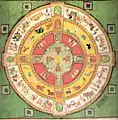Samavasarana
In Jainism, Samavasarana or Samosharana ("Refuge to All") is the divine preaching hall of the Tirthankara. The word samavasarana is derived from two words, sama, meaning general and avasara, meaning opportunity. It is a place where all have in Jain art.[1] The Samavasarana seems to have replaced the original Jain stupa as an object of worship.[2]

| Part of a series on |
| Jainism |
|---|
 |
|
|
Samavasarna Hall

In samavasarana hall, the tirthankara sits on a throne without touching it (about two inches above it).[3] Around the tirthankara sit the ganadharas (chief disciples). Living beings sit in the following order:[4]
- In the first hall, ascetics
- In the second hall, one class of deva ladies
- In the third hall, aryikas (nuns) and laywomen
- In the next three halls, three other classes of deva ladies
- In the next four halls, the four classes of devas (heavenly beings)
- Men, in the eleventh hall
- Animals, in the last hall
According to Jain texts, there would be four wide roads with four huge columns, Manasthamba (literally, pride pillar), one in each side.[5] The total size of the hall varies depending upon the height of the people in that era. The size of Rishabhadeva's samavasarana was 12 km2 (4.6 sq mi).[6]
Effects

In samavasarana, a tirthankara sits facing the east, but appears to be looking in all directions.[4] Tirthankara sits on a soft cushion while preaching the Jain philosophy in plain terms.[7] All humans and animals can understand the discourse. Jain scriptures say that all creatures who listen would become less violent and less greedy.[8] The speech of the tirthankara is distinctly heard by every one present.[4]
Gallery
 Jain manuscript page with Mahavira teaching to all creatures in Samavasarana, western India, c. 1500–1600, gouache on paper
Jain manuscript page with Mahavira teaching to all creatures in Samavasarana, western India, c. 1500–1600, gouache on paper Samavsarana of Mahavira as depicted in 19th-century art from Mysore.
Samavsarana of Mahavira as depicted in 19th-century art from Mysore. Painting of Samavasarana (Assembly hall) of a Jain Tirthankara. It depicts various beings who come to hear the preachings of the Jina peacefully
Painting of Samavasarana (Assembly hall) of a Jain Tirthankara. It depicts various beings who come to hear the preachings of the Jina peacefully Samosharan depiction
Samosharan depiction
See also
References
Citation
- Wiley 2009, p. 184.
- Shah, Umakant Premanand (1987). Jaina-rūpa-maṇḍana. Abhinav Publications. p. 15-17. ISBN 978-81-7017-208-6.
- Jain 2008, p. 95.
- Jain 2008, p. 96.
- Jain 2008, p. 93.
- "APPENDIX 14". jainworld.com.
- Jain 2008, p. 98.
- Pramansagar 2008, p. 39-43.
Source
- Rai, Champat Jain (2008), Risabha Deva (Second ed.), India: Bhagwan Rishabhdeo Granth Mala, ISBN 9788177720228
- Pramansagar, Muni (2008), Jain Tattvavidya, India: Bhartiya Gyanpeeth, ISBN 978-81-263-1480-5
- Wiley, Kristi L. (2009), The A to Z of Jainism, Scarecrow Press, ISBN 9780810868212
Further reading
- Champat Rai Jain (1929). "X: THE SAMAVASARANA". Risabha Deva - The Founder of Jainism. K. Mitra, Indian Press, Allahabad. p. 126.
